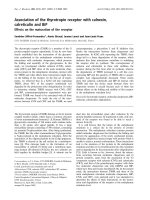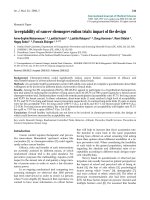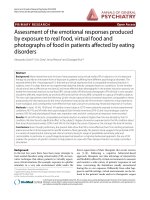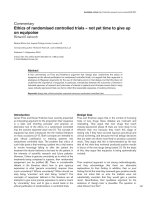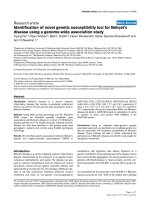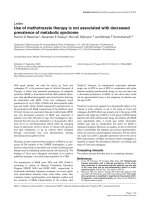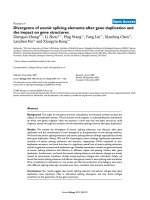Báo cáo y học: "Ethics of randomised controlled trials – not yet time to give up on equipoise Richard E Ashcroft" pps
Bạn đang xem bản rút gọn của tài liệu. Xem và tải ngay bản đầy đủ của tài liệu tại đây (38.42 KB, 3 trang )
237
Available online />Introduction
James Fries and Eswar Krishnan have recently presented
an interesting argument for the proposition that ‘equipoise
is a false and diverting principle’ and propose an
alternative test of the ethics of a randomised controlled
trial, the ‘positive expected value’ test [1]. The concept of
equipoise has been introduced into the medical literature
on many occasions [2–7]. Both concepts are intended to
give ethical justification to entering patients into
randomised controlled trials. The problem that critics of
such trials pose is that entering a patient into a trial seems
to involve knowingly failing to offer the patient the
treatment the doctor believes to be best for the patient, in
the interests of scientific research and future patients.
However, if there is genuine uncertainty as to which of the
treatments being compared is superior, then randomised
assignment can be justified [8]. There is considerable
debate in the literature about how to give rigorous
expression to what ‘genuine uncertainty’ requires. How
much uncertainty? Whose uncertainty? When should we
stop being ‘uncertain’ and start being ‘certain’? The
concepts of ‘equipoise’ defined in this literature are all
attempts to give more precise expression to what is meant
by ‘uncertainty’ here, and to give a sound basis to the
ethical justification of randomisation in controlled trials.
Design bias
Fries and Krishnan argue that in the context of licensing
trials of new drugs these debates are irrelevant and
misleading. They argue that new drugs that reach
industry-sponsored phase III trials are more likely to be
effective than not, because they reach this stage of
testing only if they have survived rigorous preclinical and
clinical screening, and because the trial design decisions
that are taken are those most likely to produce a positive
result. They argue that this is demonstrated by the fact
that all the trials they reviewed produced positive results
in favour of the new drugs being tested [1]. On the basis
of this, they argue that equipoise is being systematically
violated.
Their empirical argument is not strong methodologically,
and they acknowledge that there are alternative
explanations for their finding. In addition, their ex post
finding that all the trials they reviewed gave positive results
does not entail that ex ante the triallists were not
substantially uncertain that they would gain a positive
result. Nevertheless, their qualitative argument for the
existence of ‘design bias’ is plausible. The question is:
what follows from this?
Commentary
Ethics of randomised controlled trials – not yet time to give up
on equipoise
Richard E Ashcroft
Medical Ethics Unit, Imperial College London, London, UK
Corresponding author: Richard E Ashcroft,
Published: 14 September 2004
Arthritis Res Ther 2004, 6:237-239 (DOI 10.1186/ar1442)
© 2004 BioMed Central Ltd
Abstract
In this commentary on Fries and Krishnan’s argument that ‘design bias’ undermines the status of
equipoise as the ethical justification for randomised controlled trials, it is argued that their argument is
analogous to Bayesian arguments for the use of informative priors in trial design, but that this does not
undermine the importance of equipoise. In particular, mismatches between the outcomes of interest to
industrial sponsors of research and outcomes of interest to patients and clinicians ensure that in many
cases industry-sponsored trials can fail to reflect the reasonable equipoise of working clinicians.
Keywords: design bias, ethical principles, expected outcomes, randomised controlled trials
238
Arthritis Research & Therapy Vol 6 No 6 Ashcroft
Design bias and the Bayesians
One response is to argue that the Fries–Krishnan
argument is nothing new, because in effect the Bayesians
have been arguing something similar for years. Some
Bayesian philosophers argue that randomisation is
unnecessary in the first place, and on that basis
randomised controlled trials are unethical [9,10]. Most
Bayesian statisticians and triallists, however, do accept
that randomisation has its place in trial design [11,12].
What is required, they say, is that one starts with an
‘informative prior’ that fixes the rate at which people are
initially randomised to different arms of the trial. On this
account, something like equipoise or uncertainty remains
the ethical justification for randomisation. The concepts of
equipoise normally used are qualitative (one is either
uncertain, or not, or the community at large is uncertain or
not). Here the concept used is quantitative (one specifies
a degree of belief in the proposition that the new drug is
safe or effective, and a range of degree of belief within
which one is ‘uncertain’ as to the truth or falsity of that
proposition) [13].
As Fries and Krishnan argued, and as most Bayesians also
accept, this approach to the decision to run a trial, and to
design in it a particular way, involves subjective
judgements about what is important and about what it is
fair to offer patients. This then involves placing weight not
only on what clinicians believe, and on what they think is
important, but also on what patients believe and think
important [5,14,15].
Problems with the Fries–Krishnan–Bayesian
approach
One response to the claim that phase III trials are
systematically prone to design bias is the following.
Suppose that any new drug in phase III trials is likely to
work, at least to some extent. The primary purpose of such
a trial cannot then be to determine whether or not the new
drug is effective. Instead, it is to measure how effective it
is, and, secondly, to identify any problems with using the
drug in clinical practice (rare adverse events, the
tolerability of known side-effects, adherence to treatment,
quality-of-life issues). If this is the purpose of phase III
trials, then this will mean that different types of design and
different numbers of patients will be required in many
cases than are now required for trials that aim at proving
effectiveness alone. This may have the effect of
undermining ‘design bias’. If the origin of design bias is
sponsors selecting the design that will put their new
product in the best light, then this represents a constraint
on the designs they are entitled to choose.
Developing this, admittedly speculative, thought, even
within the Bayesian approach there is considerable
complexity. Designs that make full use of the ability to alter
the assignment of patients to arms of the trial in the light of
new information can be complex and difficult to analyse,
and the choice of prior to reflect the different degrees of
belief of sceptics or enthusiasts in the clinical and patient
communities can be controversial [12,13,16]. Designing a
trial that reflects the triallists’ confidence in the new
product, while allowing a fair test of that product, which
produces results that can be understood by, and can
hence persuade, the clinician who is neutral about the
new product is harder than it looks. Fries and Krishnan
might object that if design bias is endemic, then the
clinician ought not to be neutral about new products; this is
a very strong claim to make, however, and I will return to it.
The next problem is that a design chosen to present the
new drug in as favourable a light as possible may well not
be the design that answers the question that is clinically
relevant [17]. They may measure the ‘wrong’ outcomes or
make the ‘wrong’ comparisons. Clinicians may be
interested in the relative effectiveness of drug versus
surgery for osteoarthritis of the knee, yet they are offered
very little evidence on this type of question; patients may
be more interested in mobility than in pain control, but
mobility may not be used as an outcome measure [18,19].
Consider, therefore, the clinician who is not involved
directly with the drug development but is interested in
either participating in the trial, or (later on) in using the
results of the trial to inform her practice. On the
Fries–Krishnan view, she ought to have a prior degree of
belief in favour of the new product’s effectiveness. Other
things being equal, she seems to be being asked to
consider any new drug as an advance – otherwise why
would the drug company put all its effort into developing
it? Yet the reasonably experienced clinician will know that
new drugs are not always advances on the existing
pharmacopoeia, will not always give patients outcomes
they prefer, and may sometimes be harmful or ineffective
in practice. So how enthusiastic ought the clinician to be?
The reasonable patient deserves to be informed by his
clinician about new products and new trials, but also
about the ins and outs of such products and such trials. In
practice, these considerations would lead clinicians and
patients towards something very like equipoise, save in
those happy situations in which there is close
concordance between the interests of patients, clinicians,
triallists and sponsors.
Conclusions
Fries and Krishnan are certainly correct in arguing that the
equipoise concept has serious problems. Yet it is not the
case that it is dead in the water. For practical clinical
purposes it remains the central test of the ethical
justification for randomisation. They are also correct to
stress the role of patient autonomy and patient
preferences in the design and conduct of trials. What they
establish is that equipoise is neither a necessary nor a
239
sufficient condition for a trial to be justified. Some trials do
not require equipoise, and not all trials with equipoise are
ethically justified. For example, phase I and II trials are
rarely based on equipoise, and some trials in chronic
illness or in non-serious acute illness can be conducted
with placebo control even when there is an effective
standard therapy, provided that the patients consent and
are really free to choose the alternatives [20]. Some trials
of potentially life-saving treatments, to which there is no
effective alternative, are arguably unethical if patients have
no choice but to enter the trial [21]. Patient autonomy is
surely very important.
But the point of the equipoise principle is that doctors
need to be able to assure themselves and their patients
that the offer of randomisation is not suboptimal. The
defect of the Fries–Krishnan claim (that trials can be
ethical if there is positive expected benefit) is that this
need not be maximal: doctors, on this theory, can
knowingly and willingly do less than their best for their
patients. The point of the equipoise theory was that it
seeks to show how randomisation can be consistent with
seeking to do one’s best for one’s patient. Although
conceptual problems remain to be resolved with
equipoise, the ethical costs of giving up on it as the
default justification are high [4,5,7]. It may be that we will
eventually find a better justification for trials than
equipoise, but I am not convinced that ‘design bias’ is a
sufficient reason to give up on equipoise just yet.
Competing interests
The author declares that he has no competing interests.
Acknowledgements
I thank Ainsley Newson for commenting on a draft of this paper.
References
1. Fries JF, Krishnan E: Equipoise, design bias, and randomised
controlled trials: the elusive ethics of new drug development.
Arthritis Res Ther 2004, 6:R250-R255.
2. Fried C: Medical Experimentation: Personal Integrity and Social
Policy. Amsterdam: North Holland; 1974.
3. Freedman B: Equipoise and the ethics of clinical research.
New Engl J Med 1987, 317:141-145.
4. Miller PB, Weijer C: Rehabilitating equipoise. Kennedy Inst
Ethics J 2003, 13:93-118.
5. Veatch R: Indifference of subjects; an alternative to equipoise
in randomised clinical trials. In Bioethics. Edited by Paul EF,
Miller FD, Paul J. Cambridge: Cambridge University Press; 2002:
295-323.
6. Gifford F: Freedman’s ‘clinical equipoise’ and ‘sliding-scale all-
dimensions-considered’ equipoise. J Med Philos 2000, 25:
399-426.
7. Ashcroft RE: Equipoise, knowledge and ethics in clinical
research and practice. Bioethics 2000, 13:314-326.
8. Ashcroft RE: Giving medicine a fair trial [editorial]. BMJ 2000,
320:1686.
9. Urbach P: The value of randomisation and control in clinical
trials. Stat Med 1993, 12:1421-1441.
10. Worrall J: What evidence in evidence-based medicine? Philos
Sci 2002, 69:S316-S330.
11. Kadane JB (Ed): Bayesian Methods and Ethics in Clinical Trial
Design. Chichester: John Wiley; 1996.
12. Spiegelhalter DJ, Myles JP, Jones DR, Abrams KR: Bayesian
methods in health technology assessment: a review. Health
Technol Assess 2000, 4(38):1-121.
13. Djulbegovic B, Hozo I: At what degree of belief in a research
hypothesis is a trial in humans justified? J Eval Clin Pract
2002, 8:269-276.
14. Ashby D, Smith AFM: Evidence-based medicine as Bayesian
decision-making. Stat Med 2000, 19:3291-3305.
15. Lilford RJ: Ethics of clinical trials from a bayesian and decision
analytic perspective: whose equipoise is it anyway? BMJ
2003, 326:980-981.
16. Chard JA, Lilford RJ: The use of equipoise in clinical trials. Soc
Sci Med 1998, 47:891-898.
17. Djulbegovic B, Lacevic M, Cantor A, Fields KK, Bennett CL,
Adams JR, Kuderer NM, Lyman GH: The uncertainty principle
and industry-sponsored research. Lancet 2000, 356:635-638.
18. Dieppe P: Evidence-based medicine or medicines-based evi-
dence? Ann Rheum Dis 1998, 57:385-386.
19. Tallon D, Chard J, Dieppe P: Relation between agendas of the
research community and the research consumer. Lancet
2000, 355:2037-2040.
20. World Medical Association: Declaration of Helsinki. Revision of
2000 with note of clarification, 2002 [ />policy/b3.htm]
21. Schüklenk U: Access to Experimental Drugs in Terminal Illness.
New York: Pharmaceutical Products Press; 1997.
Available online />
